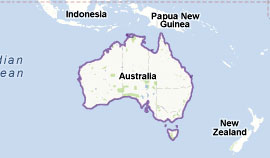Aussie teen bitten by world’s most venomous snake

The 17-year-old walked into a hospital in the small town of Kurri Kurri, north of Sydney, on Wednesday afternoon with a bite to his left hand.
According to local reports, his friend was carrying a plastic tub containing the snake, which was later identified as the toxic inland taipan.
Also known as the fierce snake due to the strength of its venom – one drop of which is enough to kill 100 adult men – the inland taipan typically lives in central Australia’s arid deserts and is not normally seen on the coast.
Detectives had been called in to investigate where the snake had come from, with speculation it could have been an illegal pet.
“The youth… is reported to be in a stable condition,” police said in a statement.
“Police are now attempting to establish how the youth came to be bitten, and hope to speak to the young man once he is considered well enough.”
Police said the incident was not believed to be linked to a nearby zoo break-in at the weekend, when thieves made off with four pythons and two alligators.
“No taipans were reported stolen from the zoo,” police said.
The snake-catcher who identified the 70-centimeter (28-inch) taipan, Barry Martin, said he had recognized its distinctive markings “straight off.”
“In days of old they were called the ‘two-step snake’, as in – it bites you, you take two steps and you’re dead,” Martin told the Daily Telegraph newspaper.
“I just put the Kevlar gloves on and picked it up… Not many people come across them in the wild.”
According to doctors, the teen’s rapid treatment with anti-venom had been crucial to his survival, as inland taipan venom can kill someone in as little as 45 minutes.
“We had anti-venom in stock, we keep what’s called polyvalent anti-venom and that covers all of our snakes,” said toxicologist Geoff Isbister, who is treating the teen at the Mater hospital in the city of Newcastle.
The snake’s poison is neurotoxic and can cause gradual paralysis and compromise breathing if not treated, with an anticoagulant element, meaning victims can also internally haemorrhage to death.
Myotoxins in the bite also dissolve muscle and other tissues, meaning the wound site can cause significant kidney damage.
Isbister said it could take weeks to recover from such a severe bite.
Inland taipans can grow up to 2.5 meters (eight feet) in length and have 12-millimeter fangs.
Because it typically lives in sparsely populated areas and is shy by nature, few humans have ever been bitten by an inland taipan, and there have been no recorded deaths.